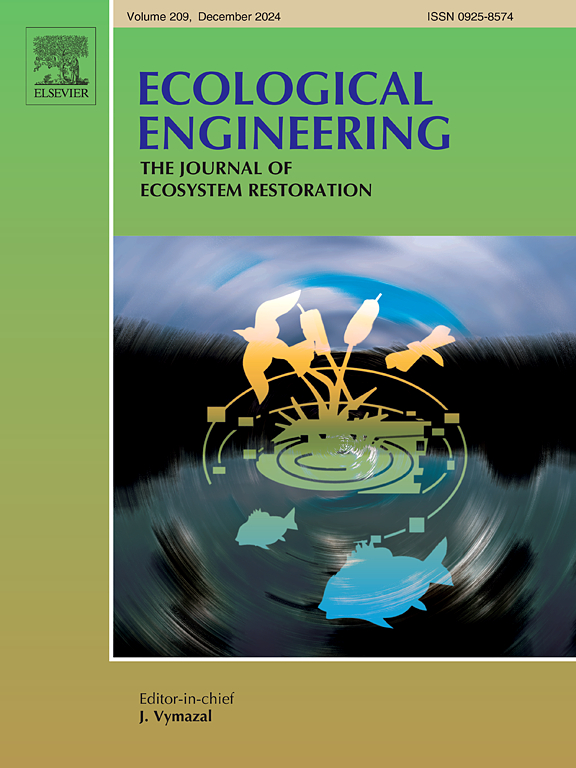整合热点、权衡和捆绑,揭示四种与水相关的生态系统服务之间的空间相互作用
IF 4.1
2区 环境科学与生态学
Q1 ECOLOGY
引用次数: 0
摘要
中国致力于推进水资源、水环境、水生态一体化治理改革,提高流域系统管理的有效性。然而,基于静态要素耦合的TWI相互作用分析仍不足以全面支持流域系统管理的需求。本研究从多功能性、相关性和优势性三个维度,通过对水相关生态系统服务(WESs)的冷热点、权衡与协同、捆绑分析,揭示了TWI内部的空间相互作用。结果表明,供水、净水、水土保持和防洪4种WESs在时间变化、结构比例和空间分布上存在显著差异。尽管单个WES热点区域呈现出明显的空间异质性,但多个WES热点区域的空间重叠覆盖了流域23.68%的面积,从而确定了多功能生态优先保护区。确定了WESs之间的六种不同的权衡和协同关系,其中协同作用占三分之二,突出了它们在TWI实施中支持双赢结果的潜力。确定了4个WESs优势明显的功能区,分别是WESs的低层平衡束、净水-供水协同束、水土保持-供水协同束和防洪-供水协同束。本研究通过对TWI空间相互作用的定量表征,为系统推进流域TWI管理提供了新的视角。本文章由计算机程序翻译,如有差异,请以英文原文为准。

Integrating hotspots, trade-offs and bundles to reveal the spatial interactions among four water-related ecosystem services for systematic watershed management
China is committed to advancing the integrated governance reform of water resources, water environment, and water ecology (Three Water Integration, TWI), aiming to enhance the effectiveness of systematic watershed management. However, interaction analyses of TWI that rely on static element coupling remain inadequate for comprehensively supporting the demands of systematic watershed management. This study reveals the spatial interactions within TWI by analyzing the cold and hotspots, trade-offs and synergies, and bundles of water-related ecosystem services (WESs), through the dimensions of multifunctionality, correlation, and dominance. The results indicate significant differences in temporal variations, structural ratios, and spatial distributions among the four types of WESs, namely water provisioning, water purification, soil conservation, and flood regulation. Although the hotspots of individual WES exhibit significant spatial heterogeneity, the spatial overlap of multiple WESs hotspots encompasses 23.68 % of the watershed area, thereby identifying multifunctional ecological priority conservation zones. Six distinct trade-off and synergy relationships among WESs are identified, with synergies comprising two-thirds, highlighting their potential to support win-win outcomes in TWI implementation. Four functional areas with distinct dominant WESs are identified, corresponding to the low-level balanced bundle of WESs, the water purification-water provisioning synergy bundle, the soil conservation-water provisioning synergy bundle, and the flood regulation-water provisioning synergy bundle. Through quantitative characterization the spatial interactions of WESs, this study provides a new perspective for the systematic advancement of watershed TWI management.
求助全文
通过发布文献求助,成功后即可免费获取论文全文。
去求助
来源期刊

Ecological Engineering
环境科学-工程:环境
CiteScore
8.00
自引率
5.30%
发文量
293
审稿时长
57 days
期刊介绍:
Ecological engineering has been defined as the design of ecosystems for the mutual benefit of humans and nature. The journal is meant for ecologists who, because of their research interests or occupation, are involved in designing, monitoring, or restoring ecosystems, and can serve as a bridge between ecologists and engineers.
Specific topics covered in the journal include: habitat reconstruction; ecotechnology; synthetic ecology; bioengineering; restoration ecology; ecology conservation; ecosystem rehabilitation; stream and river restoration; reclamation ecology; non-renewable resource conservation. Descriptions of specific applications of ecological engineering are acceptable only when situated within context of adding novelty to current research and emphasizing ecosystem restoration. We do not accept purely descriptive reports on ecosystem structures (such as vegetation surveys), purely physical assessment of materials that can be used for ecological restoration, small-model studies carried out in the laboratory or greenhouse with artificial (waste)water or crop studies, or case studies on conventional wastewater treatment and eutrophication that do not offer an ecosystem restoration approach within the paper.
 求助内容:
求助内容: 应助结果提醒方式:
应助结果提醒方式:


